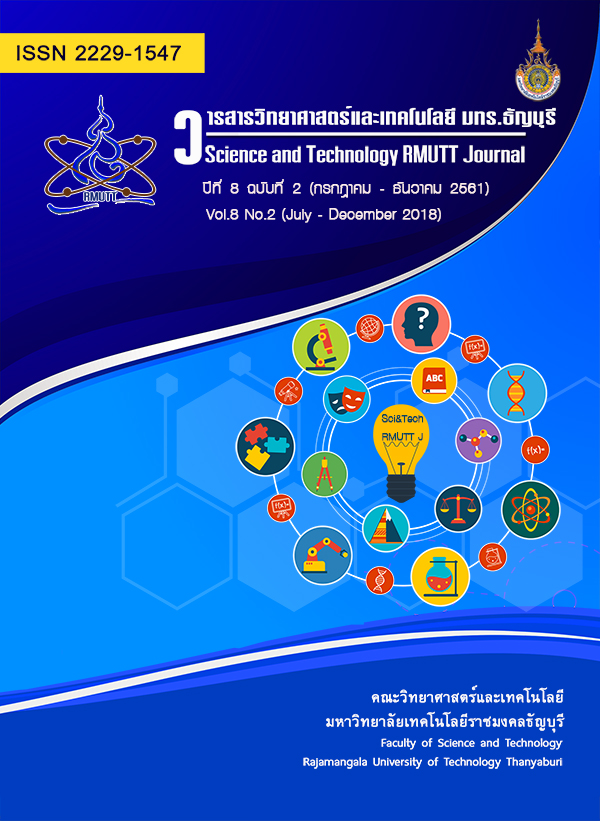Isolation and screening of plant growth promoting bacteria (PGPB) from rice (Oryza sativa) and rhizosphere soil
Main Article Content
Abstract
This study was to isolate and screen growth promoting bacteria from root, stem of rice and rhizosphere soil samples. The totally 478 bacterial isolates was isolated and screened for phosphate (P) and zinc (Zn) solubilizing activities using tricalcium phosphate (Ca3(PO4)2) and zinc oxide (ZnO) as the substrates. The results showed that the isolate AS10-1 and AR9-1 were the best of P and Zn solubilizing strains. They had solubilizing clear zone index of 1.85 and 3.43 respectively. When compared to the reference strains of Gluconacetobacter azotocaptans BCC 36449 and G. diazotrophicus BCC 20215, indicating that the reference strains exhibited P solubilizing clear zone index of 1.81 and 1.16, and Zn solubilizing clear zone index of 2.38 and 2.57 respectively, which lower than the isolated strains in this study. Screening of 41 effective bacterial isolates capable of both P and Zn solubilization for indole acetic acid production was performed and also indirect nitrogen fixation was measured by Nessler’s method. It was found that the isolate AB6-3 was the highest of Indole-3-acetic acid production with the yield of 58.25 µg/ml. It was interested that this isolate produced 3 and 4.5 times higher than that of two reference strains, respectively. The isolate NB3-3 was found to be the best nitrogen fixing activity. Identification of all 41 plant growth promoting bacteria was done using 16S rRNA gene sequencing. They were classified into 8 genera as of Gluconacetobacter sp., Cosenzaea sp., Nguyenibacter sp., Serratia sp., Ochrobactrum sp., Asaia sp., Bukholderia sp. and Pseudomanas sp.
Article Details
References
สำนักงานเศรษฐกิจการเกษตร. สถิติการเกษตรของประเทศไทย ปี ๒๕๕๙. สำนักงานเศรษฐกิจการเกษตร กระทรวงเกษตรและสหกรณ์. กรุงเทพฯ. 2559.
Gholami A., Shahsavani S. and Nezarat S. The effect of plant growth promoting rhizobacteria (PGPR) on germination, sedling growth and yield of maize. Worrld Academy of Science, Engineering and Technology. 2009. 49: 19-24.
Gupta G., Parihar S.S., Ahirwar N.K., Snehi S.K. and Singh, V. Plant growth promoting rhizobacteria (PGPR): Current and future prospects for development of sustainable agriculture. Journal of Microbial & Biochemical Technology. 2015. 7: 96-102.
Cavalcante V.A. and Dobereiner J. A new acid-tolerant nitrogen-fixing bacterium associated with sugarcane. Plant and Soil. 1988. 108: 23-31.
Phornphisutthimas S. Fermented bioextracts and agricultures. Journal of Research Unit on Science, Technology and Environment for Learning. 2012. 3: 59–65.
Raksaphol K. and Phornphisutthimas S. Control of Fusarium wilt on tomato fruit by antagonistic yeasts isolated from natural sources. The 40th National Graduate Research Conference. Songkla, Thailand. 20-21 October 2016 ; 273-275.
Chanchaichaovivat A., Kirdtabtim S. and Phornphisutthimas S. Application of microorganism in sustanable agriculture. Journal of Research Unit on Science, Technology and Environment for Learning. 2016. 7: 398-413.
Bal H.B. and Adhya T.K. Diversity of plant growth promoting rhizobacteria (PGPR) in rice soil of Odisha. Plant Science Research. 2012. 34: 27-33.
Cappuccino J.C. and Sherman N. In: Microbiology: A Laboratory Manual, 3rd ed. Benjamin/cummings Pub. Co., New York. 1992: 125–179.
Shrivastaavaaa U.P. Diversity of plant growth promoting rhizobacteria (PGPR). International Journal of Graduate Research and Review. 2016. 2: 56-64.
Seshachala U. and Tallapragada P. Phosphate soluilizers from the rhizosphere of Piper nigrum L. in Karnataka, India. Chilean Journal of Agricultural Research. 2012. 73: 397-403.
Onyia E.C. and Anyanwu C.U. Comparative study on solubilization of tri-calcium phosphate (TCP) by phosphate solubilizing fungi (PSF) isolated from Nsukka pepper plant rhizosphere and root free soil. Journal of Yeast and Fungal Research. 2013. 4: 52-57.
Zajic, J.E. and B. Supplisson. Emulsification and degradation of “Bunker C” fuel oil by microorganisms. Biotechnol. Bioeng. 1972. 14: 331-343.
Gontia-Mishra, I., S. Sapre. and S. Tiwari. Zinc solubilizing bacteria from the rhizosphere of rice as prospective modulator of zinc biofortification in rice. Rhizosphere. 2017. 3: 185-190.
Holt J.G., Krieg N.R., Sneathm P.H.A., Staley J.T. and Williams S.T. “Genus Acetobacter” Bergey’s Manual of Determinative Bacteriology, 9th ed. Baltimore, Williams and Williams, 1994: 71-94.
Khan A.L., Halo B.A., Elyassi A., Ali S., Al-Hosni K., Hussain J., Al-Harrasi A. and Lee I.N. Indole acetic acid and ACC deaminase from endophytic bacteria improves the growth of Solanum lycopersicum. Electronic Journal of Biotechnology. 2016. 21: 58-64.
Lwin K.M., Myint M.M., Tar T. and Aung W.Z.M. Isolation of plant hormone (Indolle-3-acetic acid- IAA) producing rhizobacteria and study on their effects on maize seedling. Engineering Journal. 2012. 16: 137-144.
Khan, A. L., Halo, B. A., Elyassi, A., Ali, S., Hasni, K. A., Hussain, J., Harrasi, A. A. and Lee, I. J. Indole acetic acid and ACC deaminase from endophytic bacteria improves the growth of Solanum lycopersicum. Electronic Journal of Biotechnology. 2016. 21: 58-64.
สุทธวรรณ สุพรรณ, ประดับรัฐ ประจันเขตต์ และ สิริแข พงษ์สวัสดิ์. การใช้แบคทีเรียตรึงไนโตรเจนร่วมกับวัสดุตัวกลางชีวภาพเพื่อการส่งเสริมการเจริญของพืช.วารสารวิทยาศาสตร์และเทคโนโลยี มทร ธัญบุรี. 2559. 6: 17-28.
Beneduzi A., Ambrosini A. and Passagllia L.M.P. Plant growth-promoting rhizobacteria (PGPR): Their potential as antagonists and biocontrol agents. Genetics and Molecular Biology. 2012. 35: 1044-1051.
Ramachandran, K., Srinivasan, V., Sramikkall, H. and Anandarij, M. Phosphate solubilizing bacteria isolate from the rhizosphere soil and it growth promotion on back pepper (Piper nigrum L.) cutting. Microbiological Research. 2007. 72: 325-331.
Yulianti, E. and Rakhmawati, A. Screening and characterization of phosphate solubilizing bacteria from thermophilic. The 4th International Conference on Research, Implementation, and Education of Mathematics and Science (4th ICRIEMS). Yogyakarta, Indonesia. 15–16 May 2017: 1-8.
Panhwar Q.A., Othman R., Rahman Z.A., Meon S. and Ismail M.R. Isolation and characterization of phosphate- solubilizing bacteria from aerobic rice. African Journal of Biotechnology. 2012. 11: 2711-2719.
Tilak K.V.B.R., Ranganayaki N., Pal K.K., De R., Saxena A.K., Nautiyal C.S., Mittal S., Triathi A.K.and Johri B.N. Diversity of plant growth and soil health supporting bacteria. Current Science. 2005. 89: 139-150.
Vu H.T.L., Yukkphan P., Chaipitakchonlatarn W., Malimas T., Muramatsu Y., Bui U.T.T., Tanasupawat S., Duong K.C., Nakagawa Y., Pham H.T. and Yamada Y. Nguyenibacter vanlangensis gen. nov., sp. Nov., an unusual acetic acid bacterium in the α-Proteobacteria. Journal of General and Applied Microbiology. 2013. 59: 153-166.
Abd-Alla M.H., El-Sayed E. A. and Rasmey A.M. Indole-3-acetic acid (IAA) production by Streptomyces atrovirens isolated from rhizospheric soil in Egypt. Advances in Biology & Earth Sciences. 2013. 3: 182-193.


